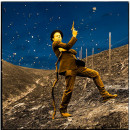Distorted polyrhythms, melodic vocals, and atmospheric layering are just some of the techniques favored by British progressive metal band, Tesseract. Hailing from Milton Keynes, England, the quintet —vocalist Daniel Tompkins, bassist Amos Williams, lead guitarist Alec Kahney, drummer Jay Postones, and rhythm guitarist James Monteith—bring a more experimental approach of the genre replete with virtuoso guitar playing, melodic solos, and pseudo-classical song structures, particularly with heavyweights like Dream Theater, Opeth, and Symphony X.
As one of the pioneers of the “djent” style of progressive metal, Tesseract sports down-tuned guitars, unconventional time signatures, and an emphasis on rhythmic over melodic instrumentation. Even within the djent movement, Tesseract has distinguished themselves from their peers, thanks to a notable use of ambiance. Whether it be through vocal layering, undistorted, melodic guitar riffs, or even a saxophone solo, the band creates an atmosphere that draws the listener into a journey. For every second that you’ll want to rock out to their music, they’ll be a moment when you just need to sit down and listen to the layers.
This additional depth is the result of conscious decisions made by the band, particularly in the instrumental department. As Monteith mentions in an interview with Guitar Player, their use of atmosphere carries over into their live performances:
When Tesseract performs live, Acle [Kahney, co-guitarist] and I generally trade off between playing riffs and the more atmospheric stuff, as well as taking turns soloing,” says Monteith…To get those spacy sounds, we use patches ranging from soft amp models combined with long reverbs to really complex chains of delays, reverbs, and choruses—sometimes with additional processing on the delay repeats. In addition to the live guitar atmospherics, we use backing tracks that include synth pads and other sounds that aren’t very prominent in the mix, but add a subtle depth to our onstage playing.
This approach has been a staple in their albums, from their debut album, One (2011), to their latest release, Polaris (2015); the latter of which debuted at No. 94 on the Billboard 200. The biggest metal bands; like Megadeth, Devin Townsend, Gojira, and Meshuggah; took note and invited them on tour.
It immediately begins with a combination of distorted polyrhythms on guitar and Tompkins’ soaring tenor vocals as he shouts the chorus, “I can feel you getting closer.”
Tesseract’s latest single, “Smile,” released in June, is a great example of the band’s refined style and signature elements that carry throughout the song. It immediately begins with a combination of distorted polyrhythms on guitar and Tompkins’ soaring tenor vocals as he shouts the chorus, “I can feel you getting closer.” Soon, he seamlessly transitions into falsetto, as he sings, “I see colossal eyes,” followed by a high-pitched yell sustained for about seven seconds.
In the verses, guitar riffs take a backseat, turning into non-distorted, yet repetitive rapid palm-mutes. This allows the meaty tone of the bass and the pummeling drums to unleash an atmosphere of uneasiness. Tompkins’ whispery vocals add yet another layer, as do lyrics like “Think for yourself and be the renegade.” The sum of the parts is unsettling, but in the best possible way.
Bassist Williams shed light on the approach and the band’s overall direction in an interview with The PRP News:
“The verses and choruses stand very far apart from each other. There is a tension we wished to build through a minimalist approach, with small phrases that repeat against accompanying parts of different lengths. These undulate, seemingly getting lost against the nonconventional phrasing of the drums. All this is nothing new to TesseracT fans, but this time we have looked to really align the lyrical and musical messages.”
While this single gives a taste on the future of the band’s sound, the band is currently in the studio working on a new, unnamed album, in between tours of Europe and the United States.
More on Tesseract













